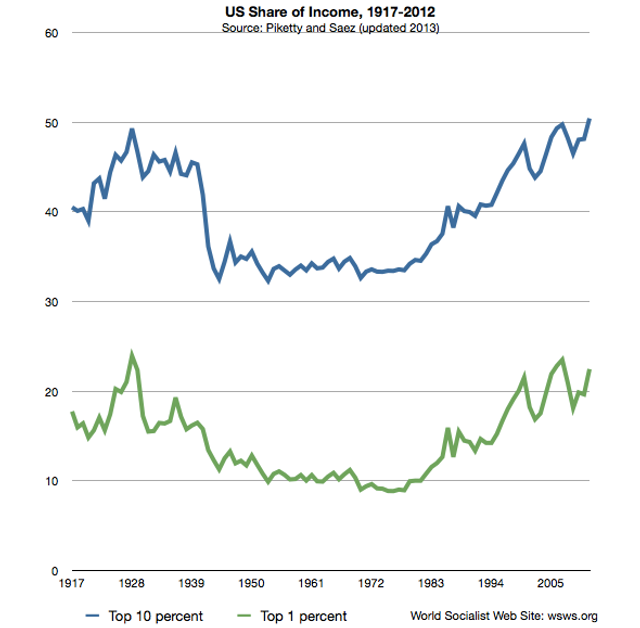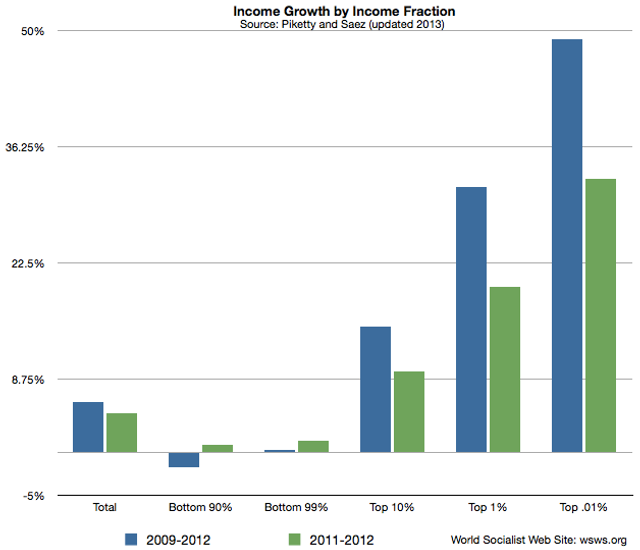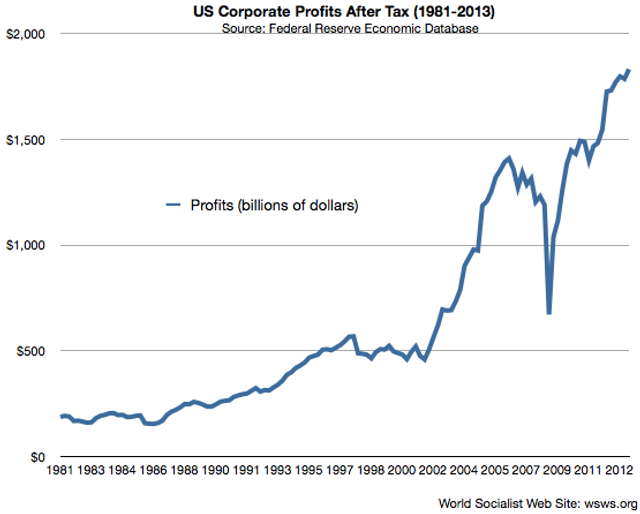US Income Inequality Soars to Highest Levels on Record

Between 2009 and 2012, total US income grew by 6 percent, according to an updated study by economists Emmanuel Saez and Thomas Piketty. However, 95 percent of this growth went to the top 1 percent. For the bulk of the population, real incomes have fallen sharply.
As a result, income inequality—measured as the share of total income going to different sections of the population—is now at or near the highest levels on record (see Figure 1).
For the first time since at least 1917, the top 10 percent of the population now takes in more than half (50.42 percent) of all income, including capital gains. The previous record, set in 2007, was 49.74 percent. The top 10 percent income share reached a pre-Great Depression peak of 49.29 percent in 1928, just before the 1929 Wall Street crash.
 Figure 1
Figure 1The vast majority of the population have suffered a decline in living standards over the past three years. Between 2009 and 2012, the income for the bottom 90 percent of the population fell significantly, by nearly 2 percent. The bottom 99 percent saw a negligible increase (0.4 percent), while the top 1 percent increased 31.43 percent and the top 0.01 percent increased nearly 50 percent (see Figure 2).
 Figure 2
Figure 2The figures from 2012 show the steady rise in inequality over the past three decades has only accelerated in the wake of the financial collapse of 2008. While the stock market fall that year led to a decline in the income for the corporate and financial elite, this wealth has been fully restored and is soaring to new heights.
This is not simply the product of abstract economic processes, but the result of deliberate class war policies implemented by the Obama administration, aimed at redistributing wealth upward. Every month, tens of billions of dollars are poured into the stock market by the Federal Reserve, with the result that share values have now exceeded their previous peek in 2008. Some 90 percent of these assets are owned by the top 10 percent with the bulk concentrated in the hands of the very rich.
The Fed’s “quantitative easing policy,” combined with government bank bailouts, has meant that trillions of dollars have been turned over to the wealthy, the very same social layer that was responsible for the crisis. As a result, new speculative bubbles have been inflated, while the bad debts of the financial aristocracy have been transferred to central banks and government balance sheets.
At the same time, wages and social programs are under relentless assault. The government has done nothing to address mass joblessness. While the nominal unemployment rate fell earlier this month to 7.3 percent, this was due almost entirely to the departure of hundreds of thousands of people from the labor force. With millions of people unable to find work, the labor force participation rate has dropped to its lowest level in 35 years (see “Labor force participation rate falls to lowest level since 1978”).
Unemployment has been used as a lever to force workers to accept lower pay. Beginning with the government-sponsored auto restructuring in 2009, the ruling class has sought to eliminate any jobs that still provide relatively decent wages and benefits. The jobs that have been created during the so-called recovery are largely low-wage and part-time.
Corporate profits have surged in line with falling wages and the rising stock market. In the second quarter of this year, after-tax profits reached a record level of $1.83 trillion dollars (see Figure 3). The share of income going to labor is near its lowest level on record.
 Figure 3
Figure 3According to the new report, between 2002 and 2007—in the aftermath of the 2001 recession set off by the collapse of the dot.com bubble—65 percent of the income growth went to the top 1 percent. This high figure, abetted by the Bush tax cuts, still pales in comparison to the 95 percent monopoly of income growth by the rich under Obama’s recovery.
The bottom 99 percent saw their incomes fall 6.5 percent from 2000 to 2002, compared to 11.6 percent between 2007 and 2009. This section of the population saw income gains of 6.8 percent between 2002 and 2007, compared to only 0.4 percent from 2009 and 2012.
In other words, incomes for the working class have fallen far more sharply and risen far more slowly during the latest economic crisis than in previous recessions, while the reverse is true for the rich.
These figures give numerical expression to social and political processes. They are proof American society is dominated by a tiny corporate and financial aristocracy that dictates policy and controls the entire state apparatus. They testify to the fact that it is impossible to change anything within the framework of the existing political system.
The social chasm revealed in these indices demonstrates both the necessity and inevitability of the enormous revolutionary struggles on the horizon.

No comments:
Post a Comment
Please leave a comment-- or suggestions, particularly of topics and places you'd like to see covered